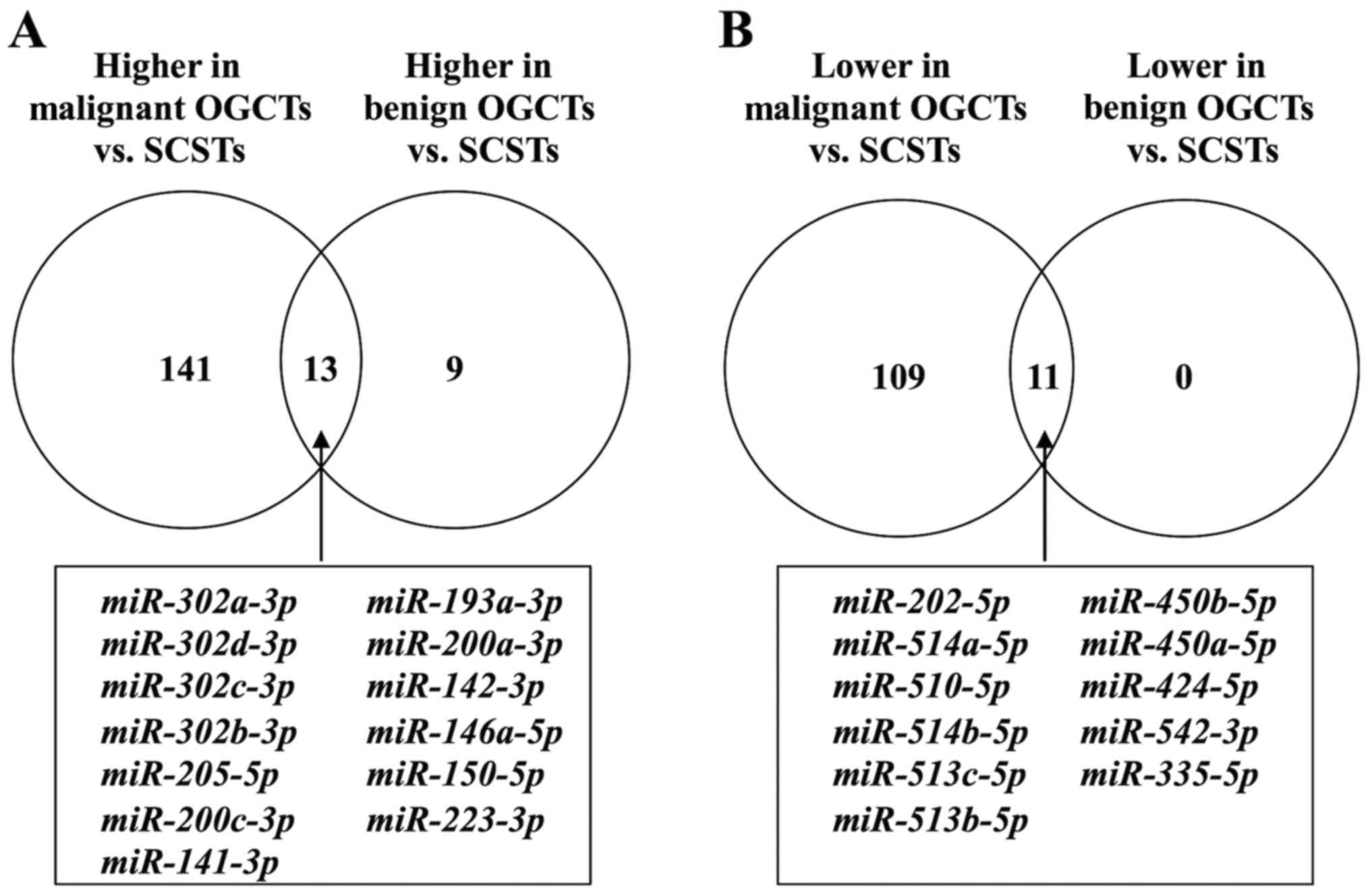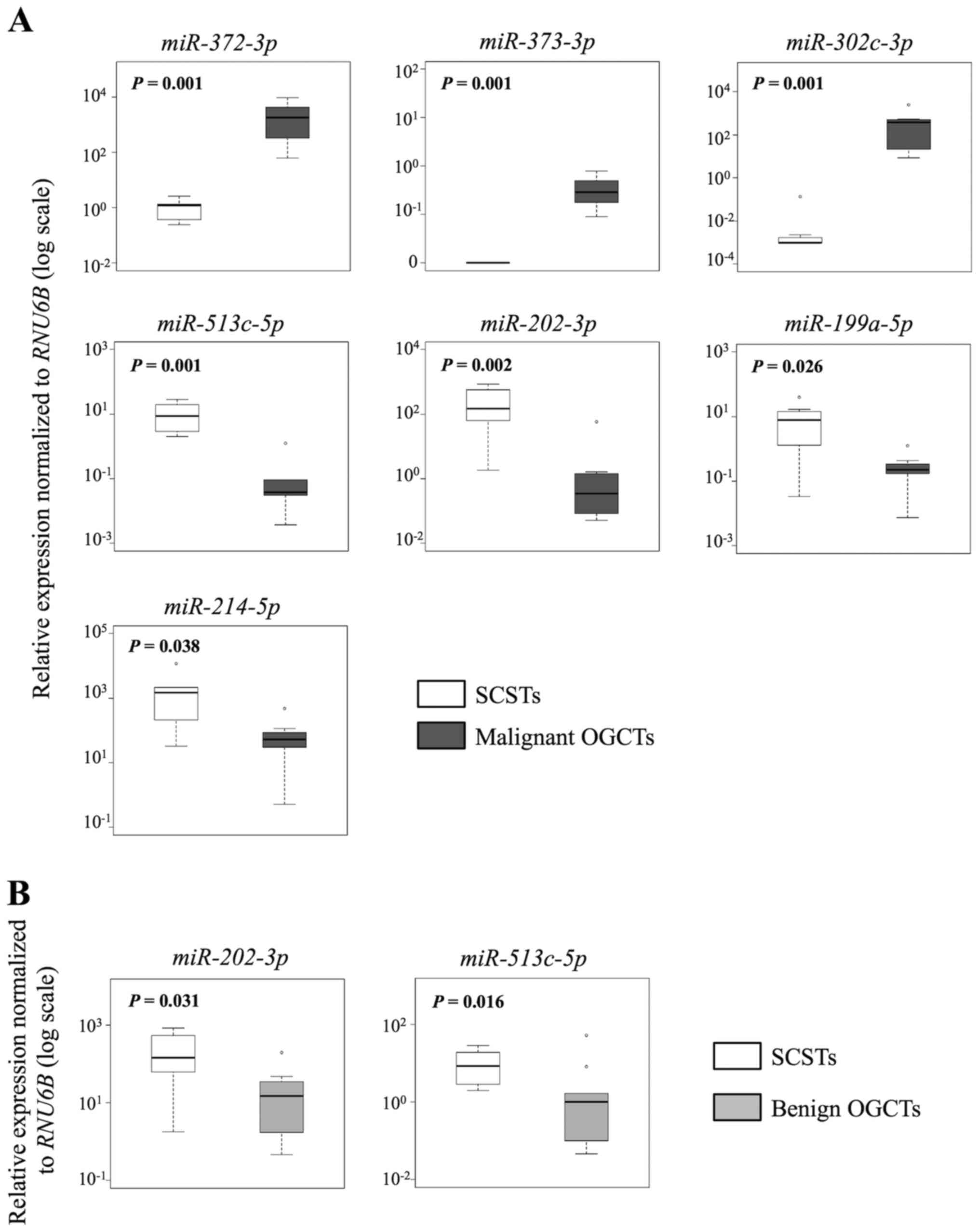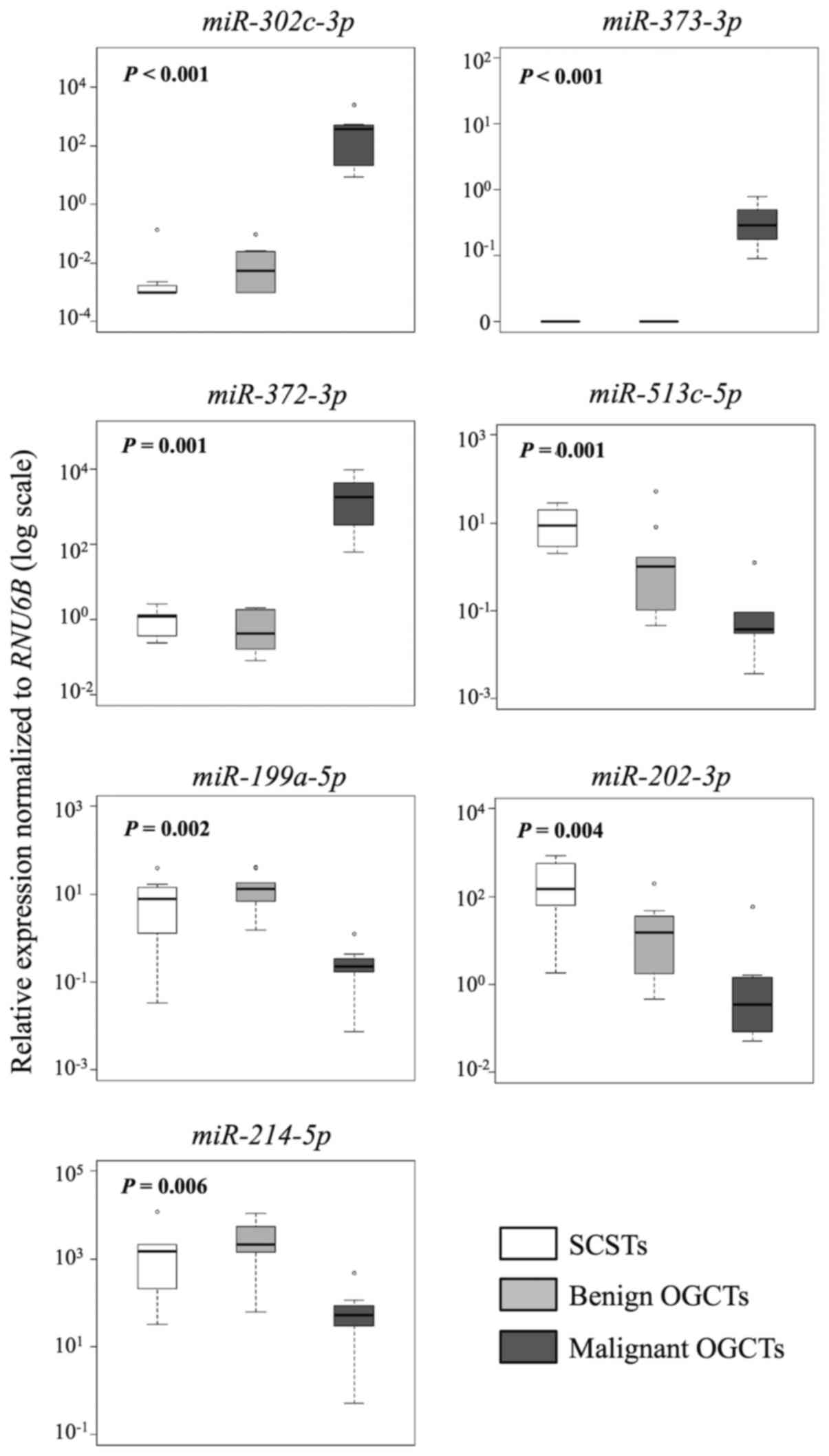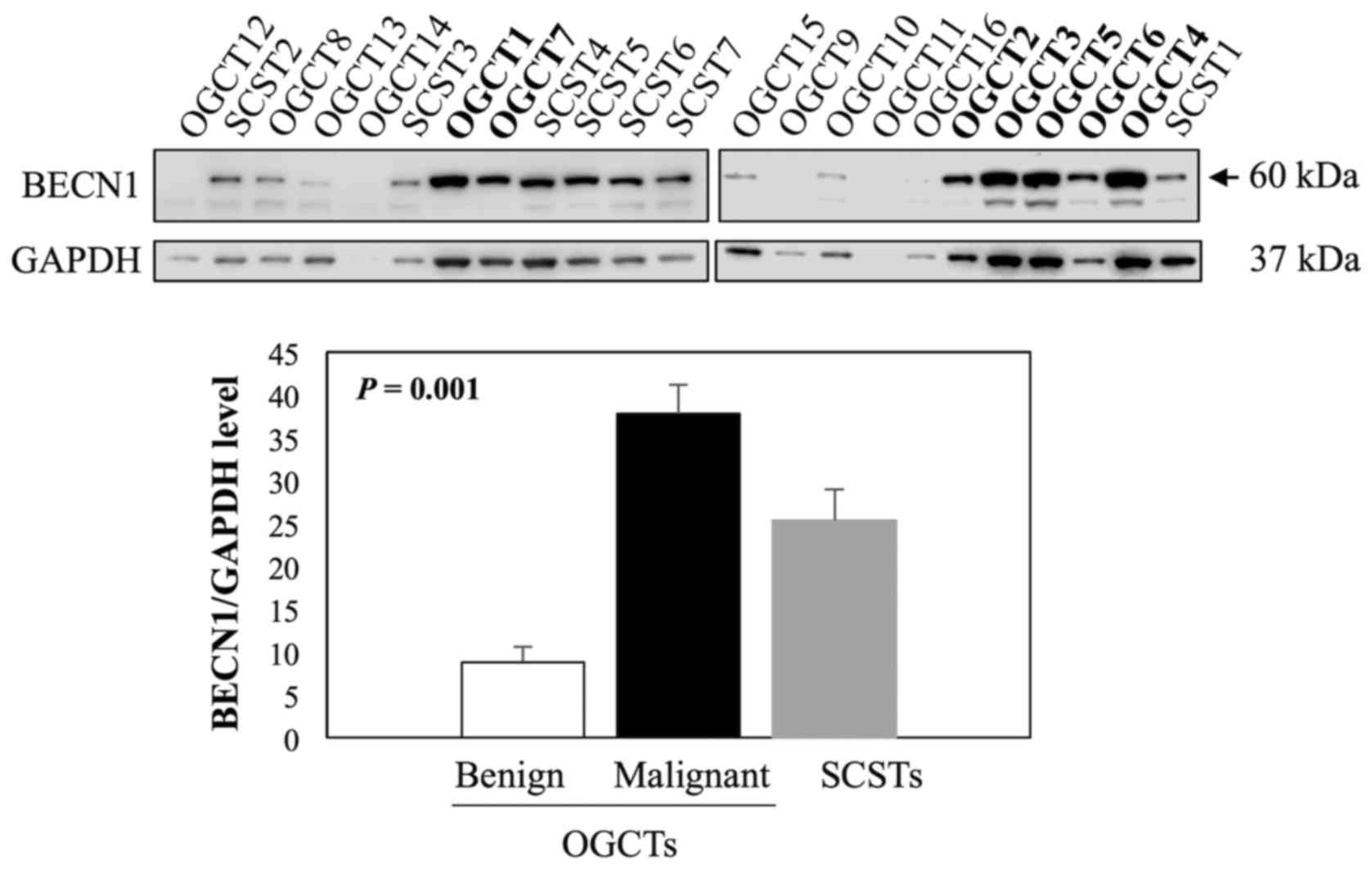MicroRNA expression profiles in non‑epithelial ovarian tumors
- Authors:
- Roger K. Chang
- Xidan Li
- Ninni Mu
- Olga Hrydziuszko
- Beatriz Garcia-Majano
- Catharina Larsson
- Weng-Onn Lui
-
Affiliations: Department of Oncology-Pathology, Karolinska Institutet, Cancer Center Karolinska, Karolinska University Hospital, SE-171 76 Stockholm, Sweden, Department of Medicine, Karolinska Institutet, SE-141 86 Huddinge, Sweden, National Bioinformatics Infrastructure Sweden, Science for Life Laboratory, SE-751 24 Uppsala, Sweden - Published online on: November 10, 2017 https://doi.org/10.3892/ijo.2017.4200
- Pages: 55-66
-
Copyright: © Chang et al. This is an open access article distributed under the terms of Creative Commons Attribution License.
This article is mentioned in:
Abstract
 |
 |
 |
 |
 |
 |
|
Curado MP, Edwards B, Shin HR, Storm H, Ferlay J, Heanue M and Boyle P: Cancer incidence in five continents Volume IX. IARC Sci Publ. 160:1–837. 2008. | |
|
Colombo N and Peiretti M: Non-epithelial ovarian cancer: ESMO clinical recommendations for diagnosis, treatment and follow-up. Ann Oncol. 20(Suppl 4): 24–26. 2009. View Article : Google Scholar : PubMed/NCBI | |
|
Kraggerud SM, Hoei-Hansen CE, Alagaratnam S, Skotheim RI, Abeler VM, Rajpert-De Meyts E and Lothe RA: Molecular characteristics of malignant ovarian germ cell tumors and comparison with testicular counterparts: Implications for pathogenesis. Endocr Rev. 34:339–376. 2013. View Article : Google Scholar : PubMed/NCBI | |
|
Chi JG, Lee YS, Park YS and Chang KY: Fetus-in-fetu: Report of a case. Am J Clin Pathol. 82:115–119. 1984. View Article : Google Scholar : PubMed/NCBI | |
|
Sergi C, Ehemann V, Beedgen B, Linderkamp O and Otto HF: Huge fetal sacrococcygeal teratoma with a completely formed eye and intratumoral DNA ploidy heterogeneity. Pediatr Dev Pathol. 2:50–57. 1999. View Article : Google Scholar | |
|
Kuno N, Kadomatsu K, Nakamura M, Miwa-Fukuchi T, Hirabayashi N and Ishizuka T: Mature ovarian cystic teratoma with a highly differentiated homunculus: A case report. Birth Defects Res A Clin Mol Teratol. 70:40–46. 2004. View Article : Google Scholar : PubMed/NCBI | |
|
Arlikar JD, Mane SB, Dhende NP, Sanghavi Y, Valand AG and Butale PR: Fetus in fetu: Two case reports and review of literature. Pediatr Surg Int. 25:289–292. 2009. View Article : Google Scholar : PubMed/NCBI | |
|
Scully RE: Classification of human ovarian tumors. Environ Health Perspect. 73:15–25. 1987. View Article : Google Scholar : PubMed/NCBI | |
|
Schultz KA, Harris AK, Schneider DT, Young RH, Brown J, Gershenson DM, Dehner LP, Hill DA, Messinger YH and Frazier AL: Ovarian sex cord-stromal tumors. J Oncol Pract. 12:940–946. 2016. View Article : Google Scholar : PubMed/NCBI | |
|
Hoei-Hansen CE, Kraggerud SM, Abeler VM, Kaern J, Rajpert-De Meyts E and Lothe RA: Ovarian dysgerminomas are characterised by frequent KIT mutations and abundant expression of pluripotency markers. Mol Cancer. 6:122007. View Article : Google Scholar : PubMed/NCBI | |
|
Murray MJ, Saini HK, Siegler CA, Hanning JE, Barker EM, van Dongen S, Ward DM, Raby KL, Groves IJ, Scarpini CG, et al CCLG: LIN28 expression in malignant germ cell tumors downregulates let-7 and increases oncogene levels. Cancer Res. 73:4872–4884. 2013. View Article : Google Scholar : PubMed/NCBI | |
|
Shah SP, Köbel M, Senz J, Morin RD, Clarke BA, Wiegand KC, Leung G, Zayed A, Mehl E, Kalloger SE, et al: Mutation of FOXL2 in granulosa-cell tumors of the ovary. N Engl J Med. 360:2719–2729. 2009. View Article : Google Scholar : PubMed/NCBI | |
|
Kim JH, Yoon S, Park M, Park HO, Ko JJ, Lee K and Bae J: Differential apoptotic activities of wild-type FOXL2 and the adult-type granulosa cell tumor-associated mutant FOXL2 (C134W). Oncogene. 30:1653–1663. 2011. View Article : Google Scholar | |
|
Kim JH, Kim YH, Kim HM, Park HO, Ha NC, Kim TH, Park M, Lee K and Bae J: FOXL2 posttranslational modifications mediated by GSK3β determine the growth of granulosa cell tumours. Nat Commun. 5:29362014. | |
|
Heravi-Moussavi A, Anglesio MS, Cheng SW, Senz J, Yang W, Prentice L, Fejes AP, Chow C, Tone A, Kalloger SE, et al: Recurrent somatic DICER1 mutations in nonepithelial ovarian cancers. N Engl J Med. 366:234–242. 2012. View Article : Google Scholar | |
|
Bushati N and Cohen SM: microRNA functions. Annu Rev Cell Dev Biol. 23:175–205. 2007. View Article : Google Scholar : PubMed/NCBI | |
|
Croce CM: Causes and consequences of microRNA dysregulation in cancer. Nat Rev Genet. 10:704–714. 2009. View Article : Google Scholar : PubMed/NCBI | |
|
Gillis AJ, Stoop HJ, Hersmus R, Oosterhuis JW, Sun Y, Chen C, Guenther S, Sherlock J, Veltman I, Baeten J, et al: High-throughput microRNAome analysis in human germ cell tumours. J Pathol. 213:319–328. 2007. View Article : Google Scholar : PubMed/NCBI | |
|
Palmer RD, Murray MJ, Saini HK, van Dongen S, Abreu-Goodger C, Muralidhar B, Pett MR, Thornton CM, Nicholson JC, Enright AJ, et al: Children's Cancer and Leukaemia Group: Malignant germ cell tumors display common microRNA profiles resulting in global changes in expression of messenger RNA targets. Cancer Res. 70:2911–2923. 2010. View Article : Google Scholar : PubMed/NCBI | |
|
Murray MJ, Saini HK, van Dongen S, Palmer RD, Muralidhar B, Pett MR, Piipari M, Thornton CM, Nicholson JC, Enright AJ, et al: The two most common histological subtypes of malignant germ cell tumour are distinguished by global microRNA profiles, associated with differential transcription factor expression. Mol Cancer. 9:2902010. View Article : Google Scholar : PubMed/NCBI | |
|
Fustino N, Rakheja D, Ateek CS, Neumann JC and Amatruda JF: Bone morphogenetic protein signalling activity distinguishes histological subsets of paediatric germ cell tumours. Int J Androl. 34:e218–e233. 2011. View Article : Google Scholar : PubMed/NCBI | |
|
Witten D, Tibshirani R, Gu SG, Fire A and Lui WO: Ultra-high throughput sequencing-based small RNA discovery and discrete statistical biomarker analysis in a collection of cervical tumours and matched controls. BMC Biol. 8:582010. View Article : Google Scholar : PubMed/NCBI | |
|
Langmead B, Trapnell C, Pop M and Salzberg SL: Ultrafast and memory-efficient alignment of short DNA sequences to the human genome. Genome Biol. 10:R252009. View Article : Google Scholar : PubMed/NCBI | |
|
Li H, Handsaker B, Wysoker A, Fennell T, Ruan J, Homer N, Marth G, Abecasis G and Durbin R; 1000 Project Genome Data Processing Subgroup: The Sequence Alignment/Map format and SAMtools. Bioinformatics. 25:2078–2079. 2009. View Article : Google Scholar : PubMed/NCBI | |
|
Anders S, Pyl PT and Huber W: HTSeq - a Python framework to work with high-throughput sequencing data. Bioinformatics. 31:166–169. 2015. View Article : Google Scholar | |
|
Robinson MD and Oshlack A: A scaling normalization method for differential expression analysis of RNA-seq data. Genome Biol. 11:R252010. View Article : Google Scholar : PubMed/NCBI | |
|
Love MI, Huber W and Anders S: Moderated estimation of fold change and dispersion for RNA-seq data with DESeq2. Genome Biol. 15:5502014. View Article : Google Scholar : PubMed/NCBI | |
|
Voorhoeve PM, le Sage C, Schrier M, Gillis AJ, Stoop H, Nagel R, Liu YP, van Duijse J, Drost J, Griekspoor A, et al: A genetic screen implicates miRNA-372 and miRNA-373 as oncogenes in testicular germ cell tumors. Cell. 124:1169–1181. 2006. View Article : Google Scholar : PubMed/NCBI | |
|
Gillis AJ, Rijlaarsdam MA, Eini R, Dorssers LC, Biermann K, Murray MJ, Nicholson JC, Coleman N, Dieckmann KP, Belge G, et al: Targeted serum miRNA (TSmiR) test for diagnosis and follow-up of (testicular) germ cell cancer patients: A proof of principle. Mol Oncol. 7:1083–1092. 2013. View Article : Google Scholar : PubMed/NCBI | |
|
Murray MJ, Halsall DJ, Hook CE, Williams DM, Nicholson JC and Coleman N: Identification of microRNAs From the miR-371~373 and miR-302 clusters as potential serum biomarkers of malignant germ cell tumors. Am J Clin Pathol. 135:119–125. 2011. View Article : Google Scholar | |
|
Özata DM, Li X, Lee L, Liu J, Warsito D, Hajeri P, Hultman I, Fotouhi O, Marklund S, Ährlund-Richter L, et al: Loss of miR-514a-3p regulation of PEG3-activates the NF-kappa B pathway in human testicular germ cell tumors. Cell Death Dis. 8:e27592017. View Article : Google Scholar | |
|
Chen BF, Suen YK, Gu S, Li L and Chan WY: A miR-199a/miR-214 self-regulatory network via PSMD10, TP53 and DNMT1 in testicular germ cell tumor. Sci Rep. 4:64132014. View Article : Google Scholar : PubMed/NCBI | |
|
Zhong X, Li N, Liang S, Huang Q, Coukos G and Zhang L: Identification of microRNAs regulating reprogramming factor LIN28 in embryonic stem cells and cancer cells. J Biol Chem. 285:41961–41971. 2010. View Article : Google Scholar : PubMed/NCBI | |
|
Nakano H, Yamada Y, Miyazawa T and Yoshida T: Gain-of-function microRNA screens identify miR-193a regulating proliferation and apoptosis in epithelial ovarian cancer cells. Int J Oncol. 42:1875–1882. 2013. View Article : Google Scholar : PubMed/NCBI | |
|
Zhao Y, Li C, Wang M, Su L, Qu Y, Li J, Yu B, Yan M, Yu Y, Liu B, et al: Decrease of miR-202-3p expression, a novel tumor suppressor, in gastric cancer. PLoS One. 8:e697562013. View Article : Google Scholar : PubMed/NCBI | |
|
Yi H, Liang B, Jia J, Liang N, Xu H, Ju G, Ma S and Liu X: Differential roles of miR-199a-5p in radiation-induced autophagy in breast cancer cells. FEBS Lett. 587:436–443. 2013. View Article : Google Scholar : PubMed/NCBI | |
|
Li Y, Jiang W, Hu Y, Da Z, Zeng C, Tu M, Deng Z and Xiao W: MicroRNA-199a-5p inhibits cisplatin-induced drug resistance via inhibition of autophagy in osteosarcoma cells. Oncol Lett. 12:4203–4208. 2016.PubMed/NCBI | |
|
Ames K, Da Cunha DS, Gonzalez B, Konta M, Lin F, Shechter G, Starikov L, Wong S, Bülow HE and Meléndez A: A non-cell-autonomous role of BEC-1/BECN1/Beclin1 in coordinating cell-cycle progression and stem cell proliferation during germline development. Curr Biol. 27:905–913. 2017. View Article : Google Scholar : PubMed/NCBI | |
|
Gawriluk TR, Hale AN, Flaws JA, Dillon CP, Green DR and Rucker EB III: Autophagy is a cell survival program for female germ cells in the murine ovary. Reproduction. 141:759–765. 2011. View Article : Google Scholar : PubMed/NCBI | |
|
Rounge TB, Furu K, Skotheim RI, Haugen TB, Grotmol T and Enerly E: Profiling of the small RNA populations in human testicular germ cell tumors shows global loss of piRNAs. Mol Cancer. 14:1532015. View Article : Google Scholar : PubMed/NCBI | |
|
Dieckmann KP, Spiekermann M, Balks T, Flor I, Löning T, Bullerdiek J and Belge G: MicroRNAs miR-371-3 in serum as diagnostic tools in the management of testicular germ cell tumours. Br J Cancer. 107:1754–1760. 2012. View Article : Google Scholar : PubMed/NCBI | |
|
Syring I, Bartels J, Holdenrieder S, Kristiansen G, Müller SC and Ellinger J: Circulating serum miRNA (miR-367-3p, miR-371a-3p, miR-372-3p and miR-373-3p) as biomarkers in patients with testicular germ cell cancer. J Urol. 193:331–337. 2015. View Article : Google Scholar | |
|
Subramanyam D, Lamouille S, Judson RL, Liu JY, Bucay N, Derynck R and Blelloch R: Multiple targets of miR-302 and miR-372 promote reprogramming of human fibroblasts to induced pluripotent stem cells. Nat Biotechnol. 29:443–448. 2011. View Article : Google Scholar : PubMed/NCBI | |
|
Fareh M, Turchi L, Virolle V, Debruyne D, Almairac F, de-la-Forest Divonne S, Paquis P, Preynat-Seauve O, Krause KH, Chneiweiss H, et al: The miR 302–367 cluster drastically affects self-renewal and infiltration properties of glioma-initiating cells through CXCR4 repression and consequent disruption of the SHH-GLI-NANOG network. Cell Death Differ. 19:232–244. 2012. View Article : Google Scholar | |
|
Yang CM, Chiba T, Brill B, Delis N, von Manstein V, Vafaizadeh V, Oellerich T and Groner B: Expression of the miR-302/367 cluster in glioblastoma cells suppresses tumorigenic gene expression patterns and abolishes transformation related phenotypes. Int J Cancer. 137:2296–2309. 2015. View Article : Google Scholar : PubMed/NCBI | |
|
Gu KL, Zhang Q, Yan Y, Li TT, Duan FF, Hao J, Wang XW, Shi M, Wu DR, Guo WT, et al: Pluripotency-associated miR-290/302 family of microRNAs promote the dismantling of naive pluripotency. Cell Res. 26:350–366. 2016. View Article : Google Scholar : PubMed/NCBI | |
|
Li HL, Wei JF, Fan LY, Wang SH, Zhu L, Li TP, Lin G, Sun Y, Sun ZJ, Ding J, et al: miR-302 regulates pluripotency, teratoma formation and differentiation in stem cells via an AKT1/OCT4-dependent manner. Cell Death Dis. 7:e20782016. View Article : Google Scholar : PubMed/NCBI | |
|
Cheung HH, Davis AJ, Lee TL, Pang AL, Nagrani S, Rennert OM and Chan WY: Methylation of an intronic region regulates miR-199a in testicular tumor malignancy. Oncogene. 30:3404–3415. 2011. View Article : Google Scholar : PubMed/NCBI | |
|
Lee YB, Bantounas I, Lee DY, Phylactou L, Caldwell MA and Uney JB: Twist-1 regulates the miR-199a/214 cluster during development. Nucleic Acids Res. 37:123–128. 2009. View Article : Google Scholar : | |
|
Cheung HH, Lee TL, Davis AJ, Taft DH, Rennert OM and Chan WY: Genome-wide DNA methylation profiling reveals novel epigenetically regulated genes and non-coding RNAs in human testicular cancer. Br J Cancer. 102:419–427. 2010. View Article : Google Scholar : PubMed/NCBI | |
|
Gu S, Cheung HH, Lee TL, Lu G, Poon WS and Chan WY: Molecular mechanisms of regulation and action of microRNA-199a in testicular germ cell tumor and glioblastomas. PLoS One. 8:e839802013. View Article : Google Scholar | |
|
Yang H, Kong W, He L, Zhao JJ, O'Donnell JD, Wang J, Wenham RM, Coppola D, Kruk PA, Nicosia SV, et al: MicroRNA expression profiling in human ovarian cancer: miR-214 induces cell survival and cisplatin resistance by targeting PTEN. Cancer Res. 68:425–433. 2008. View Article : Google Scholar : PubMed/NCBI | |
|
Chen R, Alvero AB, Silasi DA, Kelly MG, Fest S, Visintin I, Leiser A, Schwartz PE, Rutherford T and Mor G: Regulation of IKKbeta by miR-199a affects NF-kappaB activity in ovarian cancer cells. Oncogene. 27:4712–4723. 2008. View Article : Google Scholar : PubMed/NCBI | |
|
Yin G, Chen R, Alvero AB, Fu HH, Holmberg J, Glackin C, Rutherford T and Mor G: TWISTing stemness, inflammation and proliferation of epithelial ovarian cancer cells through MIR199A2/214. Oncogene. 29:3545–3553. 2010. View Article : Google Scholar : PubMed/NCBI | |
|
Sontakke SD, Mohammed BT, McNeilly AS and Donadeu FX: Characterization of microRNAs differentially expressed during bovine follicle development. Reproduction. 148:271–283. 2014. View Article : Google Scholar : PubMed/NCBI | |
|
Wainwright EN, Jorgensen JS, Kim Y, Truong V, Bagheri-Fam S, Davidson T, Svingen T, Fernandez-Valverde SL, McClelland KS, Taft RJ, et al: SOX9 regulates microRNA miR-202-5p/3p expression during mouse testis differentiation. Biol Reprod. 89:342013. View Article : Google Scholar : PubMed/NCBI | |
|
Bannister SC, Smith CA, Roeszler KN, Doran TJ, Sinclair AH and Tizard ML: Manipulation of estrogen synthesis alters MIR202* expression in embryonic chicken gonads. Biol Reprod. 85:22–30. 2011. View Article : Google Scholar : PubMed/NCBI | |
|
Tao W, Sun L, Shi H, Cheng Y, Jiang D, Fu B, Conte MA, Gammerdinger WJ, Kocher TD and Wang D: Integrated analysis of miRNA and mRNA expression profiles in tilapia gonads at an early stage of sex differentiation. BMC Genomics. 17:3282016. View Article : Google Scholar : PubMed/NCBI | |
|
Bizuayehu TT, Babiak J, Norberg B, Fernandes JM, Johansen SD and Babiak I: Sex-biased miRNA expression in Atlantic halibut (Hippoglossus hippoglossus) brain and gonads. Sex Dev. 6:257–266. 2012. View Article : Google Scholar : PubMed/NCBI | |
|
Chen J, Cai T, Zheng C, Lin X, Wang G, Liao S, Wang X, Gan H, Zhang D, Hu X, et al: MicroRNA-202 maintains spermatogonial stem cells by inhibiting cell cycle regulators and RNA binding proteins. Nucleic Acids Res. 45:4142–4157. 2017. | |
|
Eggers S, Ohnesorg T and Sinclair A: Genetic regulation of mammalian gonad development. Nat Rev Endocrinol. 10:673–683. 2014. View Article : Google Scholar : PubMed/NCBI | |
|
Streicher KL, Zhu W, Lehmann KP, Georgantas RW, Morehouse CA, Brohawn P, Carrasco RA, Xiao Z, Tice DA, Higgs BW, et al: A novel oncogenic role for the miRNA-506-514 cluster in initiating melanocyte transformation and promoting melanoma growth. Oncogene. 31:1558–1570. 2012. View Article : Google Scholar | |
|
Liu G, Sun Y, Ji P, Li X, Cogdell D, Yang D, Parker Kerrigan BC, Shmulevich I, Chen K, Sood AK, et al: MiR-506 suppresses proliferation and induces senescence by directly targeting the CDK4/6-FOXM1 axis in ovarian cancer. J Pathol. 233:308–318. 2014. View Article : Google Scholar : PubMed/NCBI | |
|
Singhal R, Bard JE, Nowak NJ, Buck MJ and Kandel ES: FOXO1 regulates expression of a microRNA cluster on X chromosome. Aging (Albany NY). 5:347–356. 2013. View Article : Google Scholar | |
|
Gross DN, van den Heuvel AP and Birnbaum MJ: The role of FoxO in the regulation of metabolism. Oncogene. 27:2320–2336. 2008. View Article : Google Scholar : PubMed/NCBI | |
|
Richards JS, Sharma SC, Falender AE and Lo YH: Expression of FKHR, FKHRL1, and AFX genes in the rodent ovary: Evidence for regulation by IGF-I, estrogen, and the gonadotropins. Mol Endocrinol. 16:580–599. 2002. View Article : Google Scholar : PubMed/NCBI | |
|
Liu Z, Castrillon DH, Zhou W and Richards JS: FOXO1/3 depletion in granulosa cells alters follicle growth, death and regulation of pituitary FSH. Mol Endocrinol. 27:238–252. 2013. View Article : Google Scholar : PubMed/NCBI | |
|
Shen M, Liu Z, Li B, Teng Y, Zhang J, Tang Y, Sun SC and Liu H: Involvement of FoxO1 in the effects of follicle-stimulating hormone on inhibition of apoptosis in mouse granulosa cells. Cell Death Dis. 5:e14752014. View Article : Google Scholar : PubMed/NCBI | |
|
Liu Z, Ren YA, Pangas SA, Adams J, Zhou W, Castrillon DH, Wilhelm D and Richards JS: FOXO1/3 and PTEN depletion in granulosa cells promotes ovarian granulosa cell tumor development. Mol Endocrinol. 29:1006–1024. 2015. View Article : Google Scholar : PubMed/NCBI | |
|
You SY, Park YS, Jeon HJ, Cho DH, Jeon HB, Kim SH, Chang JW, Kim JS and Oh JS: Beclin-1 knockdown shows abscission failure but not autophagy defect during oocyte meiotic maturation. Cell Cycle. 15:1611–1619. 2016. View Article : Google Scholar : PubMed/NCBI | |
|
Hale AN, Ledbetter DJ, Gawriluk TR and Rucker EB III: Autophagy: Regulation and role in development. Autophagy. 9:951–972. 2013. View Article : Google Scholar : PubMed/NCBI | |
|
Song ZH, Yu HY, Wang P, Mao GK, Liu WX, Li MN, Wang HN, Shang YL, Liu C, Xu ZL, et al: Germ cell-specific Atg7 knockout results in primary ovarian insufficiency in female mice. Cell Death Dis. 6:e15892015. View Article : Google Scholar : PubMed/NCBI | |
|
Herpin A, Englberger E, Zehner M, Wacker R, Gessler M and Schartl M: Defective autophagy through epg5 mutation results in failure to reduce germ plasm and mitochondria. FASEB J. 29:4145–4161. 2015. View Article : Google Scholar : PubMed/NCBI | |
|
Zhang Y, Yan L, Zhou Z, Yang P, Tian E, Zhang K, Zhao Y, Li Z, Song B, Han J, et al: SEPA-1 mediates the specific recognition and degradation of P granule components by autophagy in C elegans. Cell. 136:308–321. 2009. View Article : Google Scholar : PubMed/NCBI | |
|
Wang H, Lu Q, Cheng S, Wang X and Zhang H: Autophagy activity contributes to programmed cell death in Caenorhabditis elegans. Autophagy. 9:1975–1982. 2013. View Article : Google Scholar : PubMed/NCBI | |
|
Vera VS, Kenchappa CS, Landberg K, Bressendorff S, Schwarzbach S, Martin T, Mundy J, Petersen M, Thelander M and Sundberg E: Autophagy is required for gamete differentiation in the moss Physcomitrella patens. Autophagy. Aug 24–2017.Epub ahead of print. View Article : Google Scholar | |
|
Agnello M, Chiarelli R, Martino C, Bosco L and Roccheri MC: Autophagy is required for sea urchin oogenesis and early development. Zygote. 24:918–926. 2016. View Article : Google Scholar : PubMed/NCBI | |
|
Rossi M, Colecchia D, Ilardi G, Acunzo M, Nigita G, Sasdelli F, Celetti A, Strambi A, Staibano S, Croce CM, et al: MAPK15 upregulation promotes cell proliferation and prevents DNA damage in male germ cell tumors. Oncotarget. 7:20981–20998. 2016. View Article : Google Scholar : PubMed/NCBI | |
|
Shen Y, Li DD, Wang LL, Deng R and Zhu XF: Decreased expression of autophagy-related proteins in malignant epithelial ovarian cancer. Autophagy. 4:1067–1068. 2008. View Article : Google Scholar : PubMed/NCBI | |
|
Kandala PK and Srivastava SK: Regulation of macroautophagy in ovarian cancer cells in vitro and in vivo by controlling glucose regulatory protein 78 and AMPK. Oncotarget. 3:435–449. 2012. View Article : Google Scholar : PubMed/NCBI |










